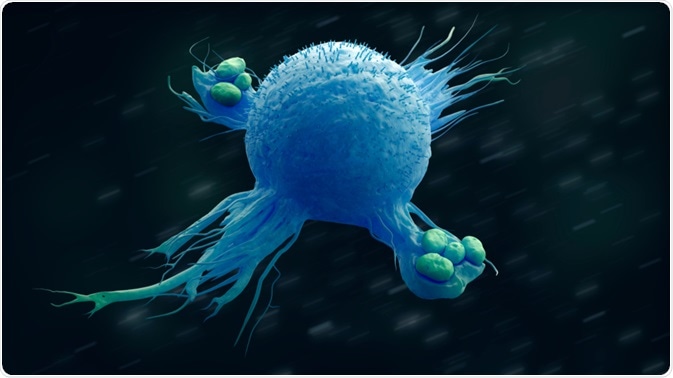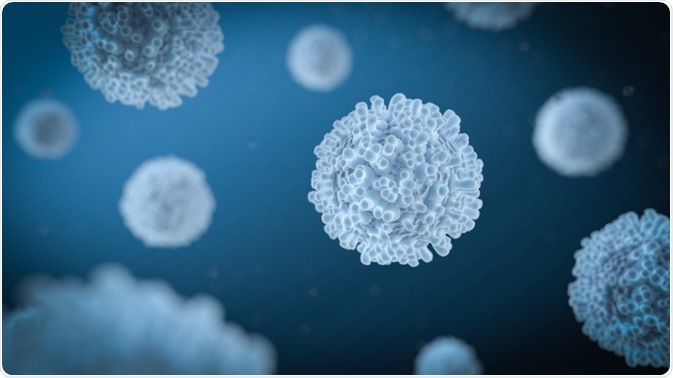The immune system is made up of two parts; innate and adaptive immunity. The body's first line of defense against pathogens is the innate (nonspecific) immune system. The acquired immunity is highly specific because it attacks a specific antigen. While the innate response is fast (minutes to hours), the adaptive response takes longer (days to weeks).

Macrophage. Image Credit: urfin/Shutterstock.com
Innate Immune Response
The primary defense mechanism against pathogens is the innate immune system which has a nonspecific immune response, responding in the same way to all pathogens and foreign substances. The first line of the defense system against microbial pathogens such as Gram-positive and Gram-negative bacteria, viruses, and fungi is the innate immune system.
Macrophages and dendritic cells are examples of innate immune cells, which directly kill microbial pathogens via phagocytosis or stimulate the secretion of cytokines, which help in pathogen elimination.
The innate immune response encompasses anatomical and physical barriers (epithelial and mucous membrane surfaces, mucus itself, tight junctions in the skin), phagocytes (macrophages, neutrophils, monocytes), lysozymes as phagocytic cell enzymes, toll-like receptors as cell receptors that sense microorganisms and signal a defensive response, and cells such as macrophages, mast cells, and natural killer cells that release inflammatory mediators and cytokines. Toll-like receptors are the most important pattern recognition receptors in the activation of innate immune responses.
The innate immune responses stimulate the development of long-lasting pathogen-specific adaptive immune responses. The main aim of the innate immune response is to immediately inhibit the movement and spread of foreign pathogens throughout the human body. Signaling cascades, which are initiated upon interaction with foreign pathogens, enhance the immune response and trigger specific mechanisms.
The innate immune mechanisms aim to inhibit pathogen entry, get rid of invader pathogens, prevent the infection establishment, trigger the acquired immune response, and clear the debris of both host and microbes. Although some of the innate mechanisms are antigen nonspecific, others include broadly specific pattern recognition molecules (PRMs), which have a role in clearing a small group of pathogens.
Innate immunity can help in eliminating the pathogen or holding the infection in check until the development of slower, lymphocyte-mediated adaptive immune responses. Additionally, innate immune cells produce cytokines, which have a pivotal role in the activation and differentiation of lymphocytes, influencing both the type and extent of the adaptive immune response.
Adaptive Immune Response
The adaptive immune responses, unlike innate immune responses, exhibit high specificity to the particular pathogen that induced them, providing long-lasting protection. For example, if someone got infected with measles and recovered, he would be protected for life against measles thanks to the adaptive immune system. However, this is not the case for all infectious diseases such as chickenpox or mumps.
Adaptive immunity aims to kill foreign pathogens and remove any toxic materials secreted by them. Because these responses are eradicative, they must be only directed to target these foreign invaders, not the host molecules. The substantial feature of adaptive immunity is to be able to distinguish what is foreign from what is self. Autoimmune diseases occur as a result of failure to make this distinction, leading to attacking the host's molecules.
Lymphocytes, which are a type of white blood cell, are the main cells that play a pivotal role in the adaptive immune response. Two different classes of lymphocytes, B cells, and T cells, are responsible for the two main classes of adaptive immune responses, called antibody response and cell-mediated immune response respectively.
The humoral response or antibody response involves B cells, which can recognize antigens or pathogens. Then, after activation of B cells through binding of antigen to receptors on the cell surface, B-cells differentiate to plasma cells, which secrete immunoglobulins or antibodies that are secreted into the bloodstream and the mucosa to inactivate antigens and toxins in a process known as neutralization.
Some B-cells are converted to memory B-cells which can be stimulated upon restimulation by specific antigens at a later time to differentiate into plasma cells. The binding of antibodies with specific antigens inactivates microbial toxins (such as diphtheria toxin or tetanus toxin) and viruses through inhibition of binding to receptors on host cells.
Antibody binding help in marking the foreign pathogens for destruction by making them easier for phagocytic innate immune cells to ingest. Antigen-bound antibodies can help in recruiting the complement system, which is an antibacterial protein system that makes pores on the pathogen surface, destroying the foreign pathogens. Additionally, the binding of antibodies to pathogens is considered to be signals for phagocytic innate immune cells to engulf the complex and remove foreign substances.
A heterogeneous group of immune cells, which are called antigen-presenting cells (APCs), include B-cells, macrophages, and dendritic cells. They have both class I and class II major histocompatibility complex (MHC). They process and present antigens for recognition by specific lymphocytes (T cells), mediating the cellular immune response.
Activation of T cells plays an important role in the adaptive cell-mediated immune response. Antigen peptides presented on class II MHC to T helper cells or class I MHC to cytotoxic T lymphocytes, along with co-stimulatory signals from APCs, stimulate naïve resting T cells to proliferate and differentiate into clones of fully activated effector T cells.
Exogenous antigens activate the T helper cells, also known as CD4+ cells, to stimulate macrophage killing of endosomal pathogens, whereas endogenous antigens activate cytotoxic T lymphocytes, also known as CD8+ cells, to kill infected cells. T cell activation also plays a role in adaptive humoral immunity, where they produce cytokines that stimulate B cells to differentiate into antibody-secreting effector cells.

Leukocyte. Image Credit: microstock3D/Shutterstock.com
References
- Willermain F, Rosenbaum JT, Bodaghi B, Rosenzweig HL, Childers S, Behrend T, Wildner G, Dick AD. Interplay between innate and adaptive immunity in the development of non-infectious uveitis. Progress in retinal and eye research. 2012 Mar 1;31(2):182-94.
- Dempsey PW, Vaidya SA, Cheng G. The art of war: Innate and adaptive immune responses. Cellular and Molecular Life Sciences CMLS. 2003 Dec 1;60(12):2604-21.
- Anaya JM, Shoenfeld Y, Rojas-Villarraga A, Levy RA, Cervera R. Autoimmunity: from bench to bedside. El Rosario University Press; 2013.
- Kumar H, Kawai T, Akira S. Pathogen recognition in the innate immune response. Biochemical Journal. 2009 May 15;420(1):1-6.
- Medzhitov R. Recognition of microorganisms and activation of the immune response. Nature. 2007 Oct;449(7164):819-26.
- Medzhitov R, Janeway Jr CA. Innate immunity: impact on the adaptive immune response. Current opinion in immunology. 1997 Feb 1;9(1):4-9.
- Hoebe K, Janssen E, Beutler B. The interface between innate and adaptive immunity. Nature immunology. 2004 Oct;5(10):971-4.
Further Reading
Last Updated: Feb 12, 2021